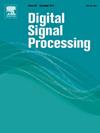Fractional lower-order covariance-based measures for cyclostationary time series with heavy-tailed distributions: Application to dependence testing and model order identification
IF 2.9
3区 工程技术
Q2 ENGINEERING, ELECTRICAL & ELECTRONIC
引用次数: 0
Abstract
This article introduces new methods for the analysis of cyclostationary time series with infinite variance. Traditional cyclostationary analysis, based on periodically correlated (PC) processes, relies on the autocovariance function (ACVF). However, the ACVF is not suitable for data exhibiting a heavy-tailed distribution, particularly with infinite variance. Thus, we propose a novel framework for the analysis of cyclostationary time series with heavy-tailed distribution, utilizing the fractional lower-order covariance (FLOC) as an alternative to covariance. This leads to the introduction of two new autodependence measures: the periodic fractional lower-order autocorrelation function (peFLOACF) and the periodic fractional lower-order partial autocorrelation function (peFLOPACF). These measures generalize the classical periodic autocorrelation function (peACF) and periodic partial autocorrelation function (pePACF), offering robust tools for analyzing infinite-variance processes. Two practical applications of the proposed measures are explored: a portmanteau test for testing dependence in cyclostationary series and a method for order identification in periodic autoregressive (PAR) and periodic moving average (PMA) models with infinite variance. Both applications demonstrate the potential of new tools, with simulations validating their efficiency. The methodology is further illustrated through the analysis of real-world air pollution data, which showcases its practical utility. The results indicate that the proposed measures based on FLOC provide reliable and efficient techniques for analyzing cyclostationary processes with heavy-tailed distributions.
求助全文
约1分钟内获得全文
求助全文
来源期刊

Digital Signal Processing
工程技术-工程:电子与电气
CiteScore
5.30
自引率
17.20%
发文量
435
审稿时长
66 days
期刊介绍:
Digital Signal Processing: A Review Journal is one of the oldest and most established journals in the field of signal processing yet it aims to be the most innovative. The Journal invites top quality research articles at the frontiers of research in all aspects of signal processing. Our objective is to provide a platform for the publication of ground-breaking research in signal processing with both academic and industrial appeal.
The journal has a special emphasis on statistical signal processing methodology such as Bayesian signal processing, and encourages articles on emerging applications of signal processing such as:
• big data• machine learning• internet of things• information security• systems biology and computational biology,• financial time series analysis,• autonomous vehicles,• quantum computing,• neuromorphic engineering,• human-computer interaction and intelligent user interfaces,• environmental signal processing,• geophysical signal processing including seismic signal processing,• chemioinformatics and bioinformatics,• audio, visual and performance arts,• disaster management and prevention,• renewable energy,
 求助内容:
求助内容: 应助结果提醒方式:
应助结果提醒方式:


